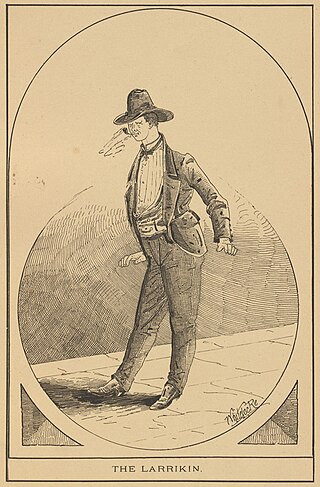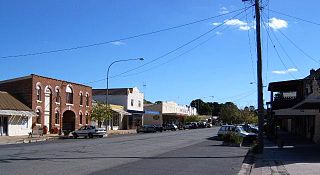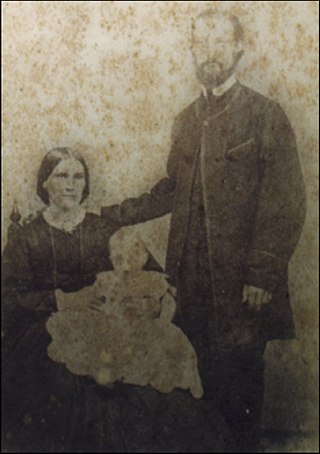
Bushrangers were originally escaped convicts in the early years of the British settlement of Australia who used the bush as a refuge to hide from the authorities. By the 1820s, the term had evolved to refer to those who took up "robbery under arms" as a way of life, using the bush as their base.

Matthew Brady was an English-born convict who became a bushranger in Van Diemen's Land. He was sometimes known as "Gentleman Brady" due to his good treatment and fine manners when robbing his victims.

Queanbeyan is a city in the south-eastern region of New South Wales, Australia, located adjacent to the Australian Capital Territory in the Southern Tablelands region. Located on the Queanbeyan River, the city is the council seat of the Queanbeyan-Palerang Regional Council. At the 2021 census, the Queanbeyan part of the Canberra–Queanbeyan built-up area had a population of 37,511.

Larrikin is an Australian English term meaning "a mischievous young person, an uncultivated, rowdy but good-hearted person", or "a person who acts with apparent disregard for social or political conventions".

Gunning is a small town on the Old Hume Highway, between Goulburn and Yass in the Southern Tablelands of New South Wales, Australia, about 260 km south-west of Sydney and 75 km north of the national capital, Canberra.
The history of the Australian Capital Territory (ACT) as a separate administrative division began in 1911, when it was transferred from New South Wales to the Australian federal government. The territory contains Australia's capital city Canberra and various smaller settlements. Until 1989, it also administered the Jervis Bay Territory, a small coastal region.
James Ainslie (1787–1844) was a Scottish soldier and shepherd, best known as the first overseer of the property known as Duntroon in the Australian Capital Territory. During his time on the Limestone Plains he is said to have had a relationship with an Aboriginal woman. After 10 years at Duntroon, Ainslie returned to Scotland and after numerous offences committed suicide in jail in 1844.

Tuggeranong Homestead is located in the Australian Capital Territory in the area now covered by the suburb of Richardson. It is a property of historical significance and is listed on the ACT Heritage Register. It was owned by a succession of prominent pastoralists over the last century before it was resumed by the Government. Today it is used as a venue for special events, conferences and weddings.

Gundaroo is a small village in the Southern Tablelands of New South Wales, Australia and in Yass Valley Council. It is situated to the east of the Yass River, about 16 kilometres (10 mi) north of Sutton, about 15 kilometres (9 mi) west of the Lake George range. At the 2016 census, Gundaroo "state suburb" had a population of 1,146. At the 2006 census, its "urban centre/locality" had a population of 331.

John Donahue, also spelled Donohoe, and known as Jack Donahue and Bold Jack Donahue, was an Irish-born bushranger in Australia between 1825 and 1830. He became part of the notorious "Wild Colonial Boys".
John Tennant was an Australian bushranger who was active around the Canberra district in the mid-1820s. Mount Tennent is named after him as it was on the slopes of this steep mountain behind the village of Tharwa where many people believed he used to hide, although this is now thought to be incorrect.
Country Cricket New South Wales is responsible for the development of cricket in regional New South Wales. It is under control of the governing body Cricket NSW.
Queanbeyan District Cricket Club is a cricket club operating in the Queanbeyan district of New South Wales and playing in the Australian Capital Territory (ACT) cricket competition. It was formally founded in 1863.

Carwoola is a locality in the state of New South Wales, Australia. It is immediately to the south of the Kowen district, which is located in the Australian Capital Territory. The Molonglo River passes through the Carwoola area before opening out into the Molonglo Plains. The Kings Highway and Captains Flat Road are the two major through routes. Carwoola is part of the Queanbeyan-Palerang Regional Council and the Southern Tablelands geographic area. The area also roughly aligns with the original Carwoola Parish.
George Gribble (1868–1947) was an Australian farmer and soldier, who won renown in tent pegging and other sports.

John Foley was a bushranger and associate of Fred Lowry. In July 1863 they robbed several mail coaches, including the Mudgee mail robbery which netted £5,700 in bank-notes. Foley was captured several weeks later with bank-notes from the Mudgee mail in his possession. He was tried at Bathurst and sentenced to fifteen-years hard labour. Foley was released in 1873; he settled in the Black Springs district near Oberon and led a respectable life until his death in 1891.
Mrs Winter, a bushranger in nineteenth-century Australia, was briefly associated with John Tennant, the ‘Terror of Argyle’; she is believed to have been the convict Mary Winter.

Henry Joseph Curran (1843-1882) was an Australian journalist and leading figure in the Catholic communities in Goulburn and Boorowa in the 1860s and 1870s. Curran worked for newspapers in Goulburn, established and edited the Burrowa Advocate and also worked in Sydney on the Freeman's Journal.

The Ginninderra blacksmith's shop is one of the most significant historical sites of the Australian Capital Territory. It was one of the first sites to be listed on the ACT Interim Heritage Places Register in 1993. The workshop is also of national importance as it is one of only a few known surviving stand-alone blacksmith shops in Australia; although, many farm-based smithies have survived. The building remains in stable condition, but there is no firm plan concerning its long-term management and it remains fenced-off and inaccessible to the public.












